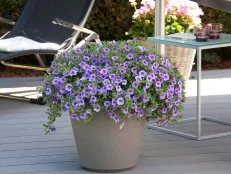How to Grow Ponytail Palm (Beaucarnea recurvata)
Easy-to-grow ponytail palm needs very little care. Use this leafy beauty, also called elephant foot plant, as a houseplant or in a sunny landscape.

Costa Farms
Native to semi-desert parts of Mexico, ponytail palms (Beaucarnea) are very easy to grow.
Some plants that we call palms — think sago palm or banana palm — aren't true palms at all. Neither is the ponytail palm (Beaucarnea recurvata). This striking and unusual-looking houseplant, which can also grow outside in dry climates with warm winters, is actually a succulent. Native to arid regions of southeastern Mexico, it belongs to the Agave family, and it's very easy to grow.
What is a Ponytail Palm?
Botanical Name: Beaucarnea recurvata
Common Name: Ponytail palm
Bloom Time: Rare; whitish or pinkish flowers
Light Needs: Full sun
to bright, indirect light
Hardiness Zones: USDA Gardening Zones 10 to 11; may overwinter in Zone 9B
Height and Width: 6 to 8 feet tall, 3 to 5 feet wide indoors; up to 30 feet tall outdoors
Growth Rate: Slow
Once you've seen a ponytail palm, you'll understand how it got its name. The plant has a large, bulbous base (called a caudex) that stores moisture and a single trunk topped by a graceful "ponytail" of long, strappy or grass-like leaves that can be straight, curly or twisted. The caudex can grow to 12 feet across in the ground or in very large containers. The mature trunk, which has gray, cracking bark and a shape like a pachyderm's foot, earns the plant its nickname: elephant foot plant. The plants are also known as bottle palms.
The leaves of elephant foot plants have tiny, sharp edges, so handle them carefully — and don't let pets nibble on them. Fortunately, ponytail palm is not toxic to cats and other pets.
Ponytail Palm Care
Light Needs
Ponytail palms like full sun. If you grow yours as a houseplant, keep it near a window that gets bright, indirect sun. Outdoors, ponytail palms need full sun. If you move your ponytail palm outside for the summer, help it acclimate to the change by first keeping it in partial shade for a few days.
Soil Requirements
Good ponytail palm care means giving your plant the right kind of soil. For a ponytail palm houseplant, use a fast-draining cactus and succulent potting soil. You can also make your own by mixing one part potting soil with one part perlite and one part sand. Outside, site a ponytail plant in organically rich, sandy soil that drains easily. A neutral pH of 6.5 to 7.5 is ideal.
How Often to Water
Drought-tolerant ponytail plants don't need much water. Grow them in containers with at least one drainage hole, and after you water, dump out any excess so they won't rot. During the summer, water elephant foot plants deeply and wait until the top two or three inches of soil feel dry to the touch, or about every seven to 14 days, before watering again. Clay pots are a good choice because they dry out faster than pots made from other materials.
When grown outside, Beaucarnea recurvata seldom needs watering if you have relatively regular rainfall. If grown outdoors in a dry climate or during a period of drought, ponytail palm care requires watering your plant moderately every two weeks while it's actively growing. Outdoor ponytail palms don't get much moisture in the winter, so reduce watering to every few weeks when the temperatures drop. Water deeply when you do water.
Fertilizer Needs
Apply an all-purpose fertilizer or one made for cacti and succulents once in spring and once in summer. Don't use a palm fertilizer and don't feed when growth slows down in the winter. Follow the directions on the product label for how much and how often to apply.
Temperature Preference
Elephant foot plants prefer dry conditions with temperatures from 60 to 85 degrees. Bring potted ponytail palms inside when the temperatures stay consistently below 45 degrees. Room temperatures from 50 to 55 degrees are fine in the winter, but keep them away from cold windows, vents and drafts. Outdoor temperatures below 20 degrees usually kill ponytail palms.
How to Plant Ponytail Palm
In Zones 10 and 11, ponytail palms can be planted outdoors, where they can grow 10 to 30 feet tall. Some sources report successfully overwintering ponytail palm trees outdoors in Zone 9B. Check your zone here.
Indoors, ponytail plant can grow into a small tree, or about 1 to 3 feet tall and 1 to 4 feet wide. Growth is slow. You can limit the plant's size by keeping it in a small, shallow container with drainage holes. If you want it to get bigger, repot your plant. Go up one pot size at a time so there's about one inch between the trunk and the rim of the pot.
When planting, leave half of the large base above the soil.
Should You Cut Off Brown Tips?
Ponytail palm doesn't really need pruning, but you can snip off any brown leaf tips that appear; they can be caused by overwatering or overfertilizing. If too much water makes your plant's roots brown and mushy, remove them and repot the plant in dry, fresh potting medium.
What an Underwatered Ponytail Palm Looks Like
Underwatering can cause ponytail palm leaves to droop or turn brown and curl or make the trunk wrinkled and limp. To rehydrate your plant, put it in a sink filled with a few inches of room temperature water and let it soak up the water through the drainage hole in the bottom of the pot. When the top of the soil feels saturated, drain the sink and the plant. Cut off any leaves that have become crispy and brown, but don't remove more than 20% of the foliage at one time.
How to Fix a Ponytail Palm Problems
Pests
Like many houseplants, ponytail palm can be attacked by spider mites and mealybugs. Rinse them off with a spray of tepid water from your kitchen sink or in the bathtub or use a horticultural soap or Neem oil to banish them. Remove infected plant parts and discard them in the trash — not in your compost pile, where the problem can spread. If your ponytail palm problem is scale, remove the pests by gently rubbing them off with a cloth moistened with water and a little dishwashing soap. Quarantine your plant until you're sure the pests are gone so they don't spread to other houseplants.
Diseases and Other Ponytail Plant Problems
Ponytail palms don't suffer from many diseases, but overwatering can lead to root and stem rot. You may be able to save your plant by letting it dry out for a while or repotting it in a cactus and succulent potting mix with good drainage. To control fungal diseases, use a spray labeled for that use and make sure your plant has good air circulation.
Cacti-succulent potting mix is low in nutrients, so if your plant's leaves turn yellow, it may need more manganese, nitrogen or magnesium. Use a soil test kit available from nurseries and garden centers to test for deficiencies and apply a slow-release fertilizer to add what is lacking. Be patient, since slow-release fertilizers take a while to show results. Yellow leaves can also signal overwatering or insufficient sunlight, so adjust as needed.
Propagating Ponytail Palm
Ponytail palms are dioecious, which means they can be male or female. Only females set seeds, and only if they're pollinated by male plants. Indoor ponytail palms rarely flower, and if they do, it's been reported flowering can take up to 30 years after planting.
Although your plant probably won't set seeds, you can buy them, and they're easy to grow. Before planting, pre-soak them overnight or gently scarify them (nick them with a knife) to help loosen their hard seed coats. Sow them 1/4- to 1/2-inch deep in 3-inch containers filled with a loose, gritty soil mix, such as a mixture of four parts sand to two parts peat, one part sterile soil and one part perlite. Germination can take 14 to 28 days or more. Moisten the mix and sow the seeds over it, gently pressing them down and cover them lightly with a sprinkling of sand.
Keep the pots lightly misted in a spot where the temperature stays at least 68 degrees. Cover them with plastic and put them on a heating pad for faster germination. Pull the plastic back once a day so excess moisture can escape. Keep the pots in a brightly lit area but out of direct sun. Once the seeds sprout, remove the heating mat and plastic. Keep misting the seedlings and water them deeply but not often. Reduce watering by half in the winter. Feed them with an all-purpose liquid plant food, diluted by half, once in the spring and once in the summer.
You can also propagate ponytail palm by division. The best time to do this is in the spring.
- Using a clean, sharp knife and — wearing gloves to protect your hands from the serrated leaves — cut off any side shoots, called pups, that form on your plant. Choose pups that are about four inches long.
- Remove enough leaves from the bottom of each pup to give it a stem.
- Let the cut area dry for a day or two to help prevent rotting and then dip the ends of the stems in rooting hormone.
- Insert them about one-third of their length into pots filled with a well-draining potting medium, such as a mix of sand and peat. Gently firm the medium around them.
- Add a layer of decorative pebbles, if needed, to hold them securely. Water and drain off any excess.
Types of Ponytail Palm to Grow
There are four common types of ponytail palms; B. recurvata, formerly B. nolina, is the most common. 'Gold Star' is a cultivar with narrow, green leaves with creamy-yellow margins and tinges of red.
B gracilis has long, slender leaves that are a dull, grayish-green to blue.
B. stricta is a very slow-growing ponytail plant that matures at about 20 feet tall. It has long, stiff, blue-gray grasslike leaves.
B. guatemalensis is also called red ponytail plant. It matures around 15 feet tall with long, green, glossy, slightly twisted leaves. New leaves often have a red flush at the base.












































